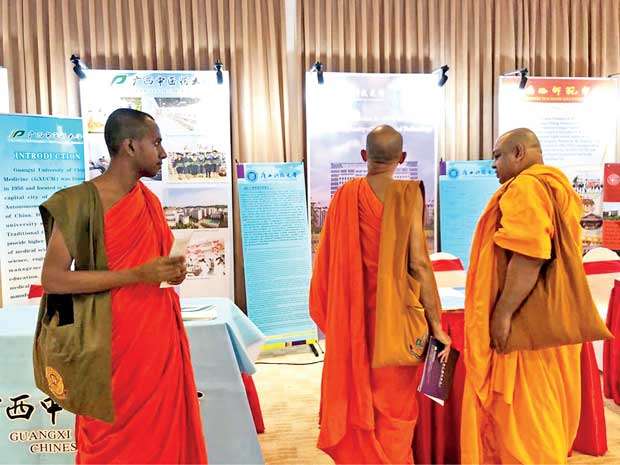Reply To:
Name - Reply Comment
Last Updated : 2024-04-27 00:40:00

Sri Lankan monks explore possibilities of studying in China Photo Tang Lu
 In 1990, Harvard Professor Joseph S. Nye, called such an approach to building up support as the use of “soft power”. The aim of “soft power” is to create, in another country, a favourable impression of the “power” in question, modifying the impact of military or economic might.
In 1990, Harvard Professor Joseph S. Nye, called such an approach to building up support as the use of “soft power”. The aim of “soft power” is to create, in another country, a favourable impression of the “power” in question, modifying the impact of military or economic might.
Soft power involves the use of non-coercive means such as economic and technical aid, education, culture and communication.
Educational institutions are key instruments of soft power. Following the example of the Soviet Union and Russia, resurgent China, aiming to be respected in the world as a benign and responsible power in the face of Western skeptical propaganda, is using its gargantuan educational facilities to recruit, and perhaps influence, foreign students from across the world, especially those in its backyard and on the Belt and Road path girdling the earth.
In 2014, Chinese President Xi Jinping gave a boost to this movement when he said: “We should increase China’s soft power, give a good Chinese narrative, and better communicate China’s message to the world.”
Chinese universities, being mostly State-owned, do not lay stress on making money and are eminently affordable
To familiarize foreigners with Chinese thought and culture, China opened the first Confucius Institute (CI) in 2004. And by January 2018, there were more than 500 CIs across the world, including one in Colombo University. The CI is a non-profit organization. It also provides Mandarin language courses, cooking and calligraphy classes.
Mounting Foreign Student Population
Chinese official statistics show that in 2017 students from 204 countries were studying in 935 Chinese higher education institutions located in 31 provinces, autonomous regions and municipalities. These included 75,800 graduate and doctoral students, an increase of 18.62% compared to 2016.
In 2017, 489,200 foreign students were studying in China, marking an increase of over 10% for the second consecutive year. The number of degree students reached 241,500 (49.38% of the total), up 15.04% year on year. A growing number of foreign students have been going for a Master’s or PhD across a widening range of disciplines.
By end 2017, China was the most popular destination for international students in Asia. Most students came from South Korea, Thailand, Pakistan, the US, India, Russia, Japan, Indonesia, Kazakhstan, and Laos, in that order.
The number of students from ‘Belt and Road’countries accounted for 64.85% of all international students in China. In absolute numbers they were 317,200. This was an increase of 11.58% over the earlier year.
By end 2017, China was the most popular destination for international students in Asia
The above statistics are significant because China’s Belt and Road infrastructure projects in various parts of the world are creating jobs for students with knowledge of the Chinese language or students who have studied in China. Students are now enthused to study Chinese and in China because of this.
Reasonable Cost
The high fees charged by profit-making Western universities are a deterrent to students from developing countries. But Chinese universities, being mostly State-owned, do not lay stress on making money and are eminently affordable.
The average tuition fees in public universities in China range from US$ 3,300 to US$ 10,000 per year. Fees for an English-medium degree course are from US$ 2,200 to US$ 4,500 per year. On an average, foreign students spend around US$ 4,000 for accommodation and about US$ 2,000 for other living needs per year.
There are American and British universities with campuses in China. But these are costly. Tuition fees here start from US$ 8,000 and go to US$ 15,000 a year. A few like Beijing University charge US$ 17,000 a year.
An MBBS student’s total expense (including living expenses) per year in China is US$ 7,500. But in the UK, it would be US$ 30,500 and in the United States, US$ 35,000. Even Indian private colleges charge more - US$ 14,700 a year.
Role of Scholarships
Scholarships offered by the Chinese government have allowed an increasing number of foreign students to pursue higher education in China.
In 2017, 58,600 foreign students from 180 countries were awarded Chinese government scholarships, accounting for 11.97% of the total. 88.02% of the recipients were degree students (51,600); 69.57% (40,800) were post-graduate or doctoral students, marking an increase of 20.06% compared to 2016. However the number of self-funded students was 430,600, accounting for 88.03% of all overseas students.
48.45% of foreign students were enrolled for liberal arts degrees. Those majoring in engineering, management, science, art and agronomy increased by 20% year on year.
Liu Dong, Director of the Cultural Section in the Chinese Embassy in Colombo, said that the Chinese government offers Sri Lankans 80 scholarships in addition to many other full or partial scholarships offered by the Confucius Institute and Chinese provincial governments.
Hard Sell By Guangxi Province
Recently, the “Study in Guangxi” Education Exhibition in Colombo, drew a steady stream of Sri Lankan students. 25 higher educational institutions from Guangxi Province offered a wide variety of courses in the liberal arts,
Recently, the “Study in Guangxi” Education Exhibition in Colombo, drew a steady stream of Sri Lankan students
management, technology, science, medicine, Chinese language, tourism and teaching.
 Qin Ping, Deputy Party Secretary of the Working Committee of Higher Education Institutions of the Guangxi Zhuang Autonomous Region, said that over the past five years, the number of international students in Guangxi has grown at an annual rate of 20 percent.
Qin Ping, Deputy Party Secretary of the Working Committee of Higher Education Institutions of the Guangxi Zhuang Autonomous Region, said that over the past five years, the number of international students in Guangxi has grown at an annual rate of 20 percent.
In 2017, more than 14,000 international students from 118 countries were studying in Guangxi, among which more than 12,000 students were from Asia. The number of Sri Lankan students going to Guangxi has gone up to 100 from 35 in 2012.
In a hard sell, the stalls at the Guangxi exhibition were staffed by smiling and communicative Chinese youth, eager to answer questions put by the students. The well-lit displays showed beautiful campuses set in verdant surroundings.
Besides beating the drum about the high quality of education the institutions offer and that at an affordable price, the brochures made it a point to say that the campuses provide foreign students with good living conditions, thus addressing a major concern of students from developing countries who are unfamiliar with China.
Meets a Felt Need
The response from Sri Lankan students was good because there is a tremendous shortage of institutions of higher learning in the island. As the Additional Secretary of the Higher Education Minister Madhawa Devasurendra said, Sri Lankan students who qualify for university admission far outnumber available seats.
In 2017, more than 14,000 international students from 118 countries were studying in Guangxi
Those who fail to make it to the university either opt out of higher learning or go for expensive degrees and diplomas offered by teaching shops which prepare students for exams conducted by Western Universities and colleges of varying quality and credibility.
Has China’s Bid Been Effective?
Natalie Hong’s 2014 study of EU-China education diplomacy found that 50% returned from China with a positive impression, while around 40 % returned with an unchanged impression.
The score would improve if the Chinese mix with the foreigners more, giving up their insularity and prejudices and also learn to speak English.
David Shambaugh, writing in Foreign Affairs in 2015 said that China’s tightening authoritarian political system was the biggest obstacle to the positive image the country.
“So long as China’s political system does not enable free human development, its propaganda efforts will face an uphill battle,” Shambaugh wrote.

Add comment
Comments will be edited (grammar, spelling and slang) and authorized at the discretion of Daily Mirror online. The website also has the right not to publish selected comments.
Reply To:
Name - Reply Comment
US authorities are currently reviewing the manifest of every cargo aboard MV
On March 26, a couple arriving from Thailand was arrested with 88 live animal
According to villagers from Naula-Moragolla out of 105 families 80 can afford
Is the situation in Sri Lanka so grim that locals harbour hope that they coul

26 Apr 2024
26 Apr 2024